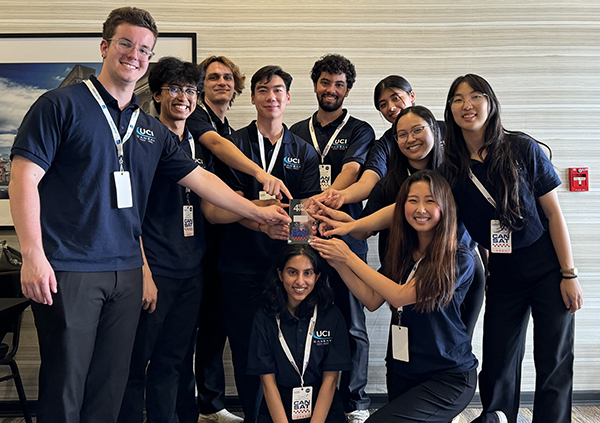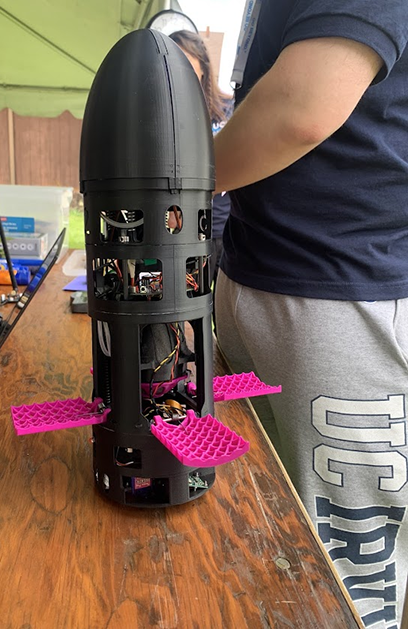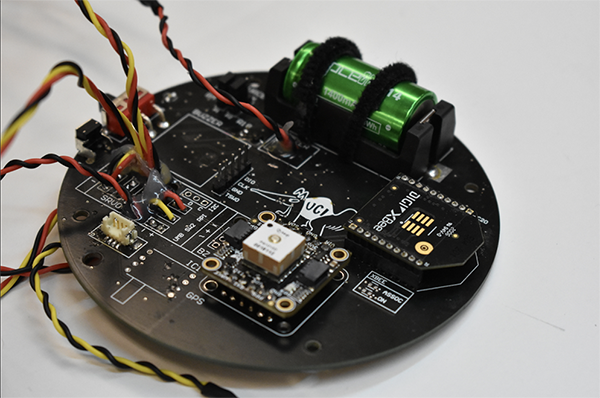Anteater CanSat Team Takes Second Place in U.S., Fourth Worldwide

July 11, 2024 - The UCI CanSat team won second place in the United States and fourth place worldwide in the 2024 CanSat Student Competition in June in Staunton, Virginia.
The annual competition, hosted by the American Astronautical Society in conjunction with the U.S. Naval Research Laboratory, is a unique opportunity for university students to develop, build and launch a soda can-sized satellite designed to meet specific mission objectives.
This year’s challenge required the students to design and integrate electrical, mechanical and software components to simulate the landing sequence of a planetary probe. The CanSats were launched to an altitude of approximately one kilometer, where they needed to collect data, send radio-frequency telemetry, and activate heat shields and parachutes to ensure a controlled descent and intact landing. Out of the 140 competing teams, only 32 were invited to the launch event.

Ten members of UCI’s CanSat team traveled to Virginia for the competition. Team lead Ryan Liu, a fifth-year electrical engineering major, said his team had a novel design. “One of the cool things about our CanSat was that the mechanical team developed the actual nose cone of the rocket to act as an aero-braking heat shield. The other teams were impressed with our design because everything was integrated into one mechanic.”
They also borrowed an idea from SpaceX and used pink grid fins around the base to prevent wobbling on the descent. “This helped us achieve rotational control and allowed a more steady descent,” said Liu. “We’re judged not on the ascent, but on going down. Once the CanSat ejects from the rocket, it goes through the whole activation sequence as it descends. That’s when it collects information.”
Kaylee Kim, a second-year mechanical engineering major who served as a software engineer for the CanSat, will lead the team next year. She said they learned a lot from this competition and she gained some important takeaways. “Everything was working independently before we left and got on the plane to Virginia. So, we were very chill thinking that everything would be fine.”
However, the day before the competition, when they put it all together and conducted final testing, it did not work. There were problems with the flight software and flow -- certain triggers were not activating the sequence of mechanisms. “Because we had been testing each subsystem independently, we kind of assumed it would work altogether, but it turned out it was too much for our power supply,” Kim explained.
They ended up pulling an all-nighter the day before launch and had to make some hard decisions. “One of the big issues with the power supply was the camera, so we decided to get rid of it, as it was only a small percentage of the scoring,” said Liu.

This proved to be the right decision as the UCI CanSat performed so well on launch day, even though the team was operating on just a few hours of sleep.
“It’s been one of the most interesting engineering experiences I’ve ever had,” said Liu, who begins a job as technical program manager at Google in the fall.
“As a multidisciplinary effort, it takes a dedicated group of students to successfully design and integrate the mechanical, electrical and software components of the project in only nine months,” said Roger Rangel, professor emeritus and the team’s faculty adviser. He noted that this is the highest rank the UCI team has achieved in seven years of participating in the international contest .“This is a greatly deserved accomplishment as this year's team was made up of students deeply committed to success.”
– Lori Brandt
